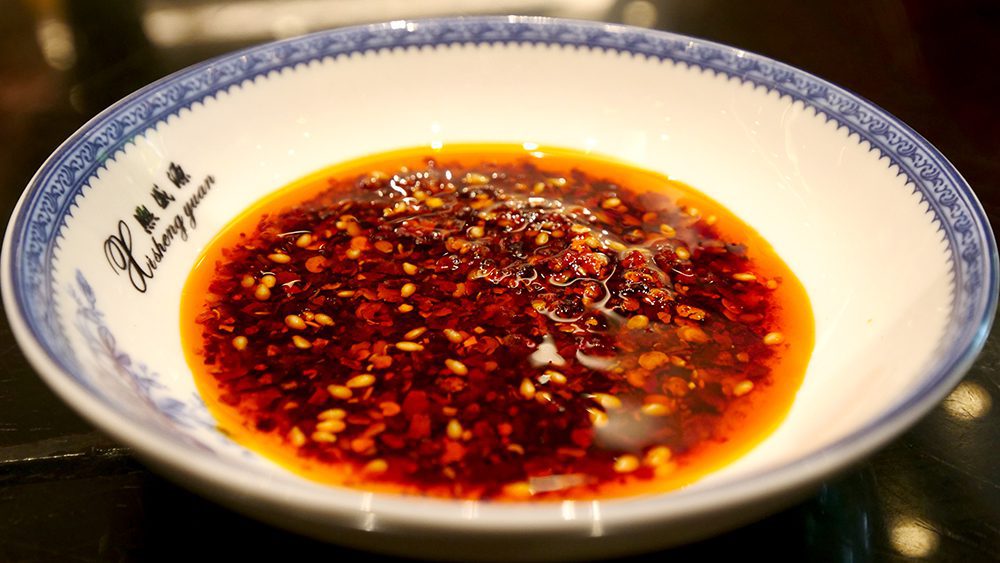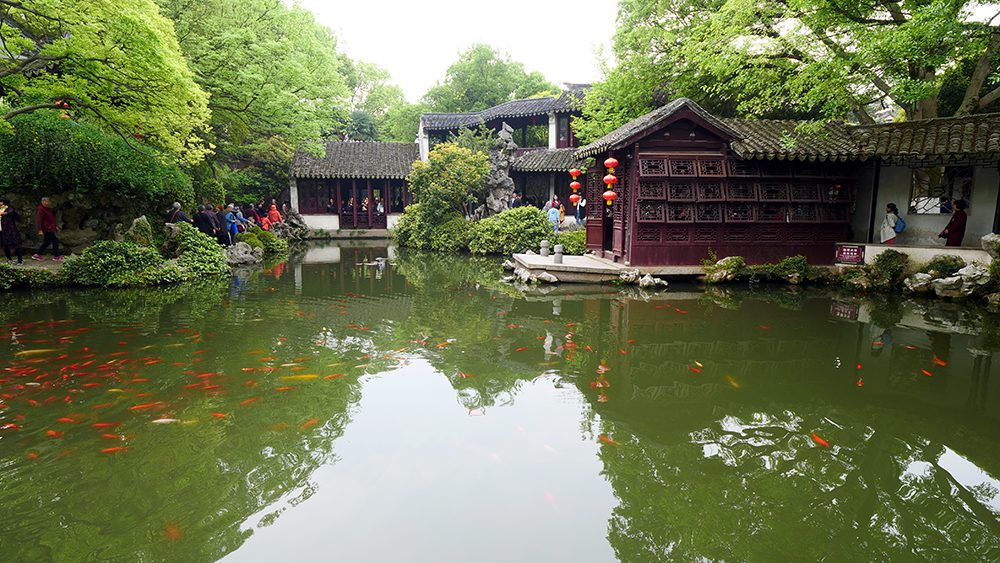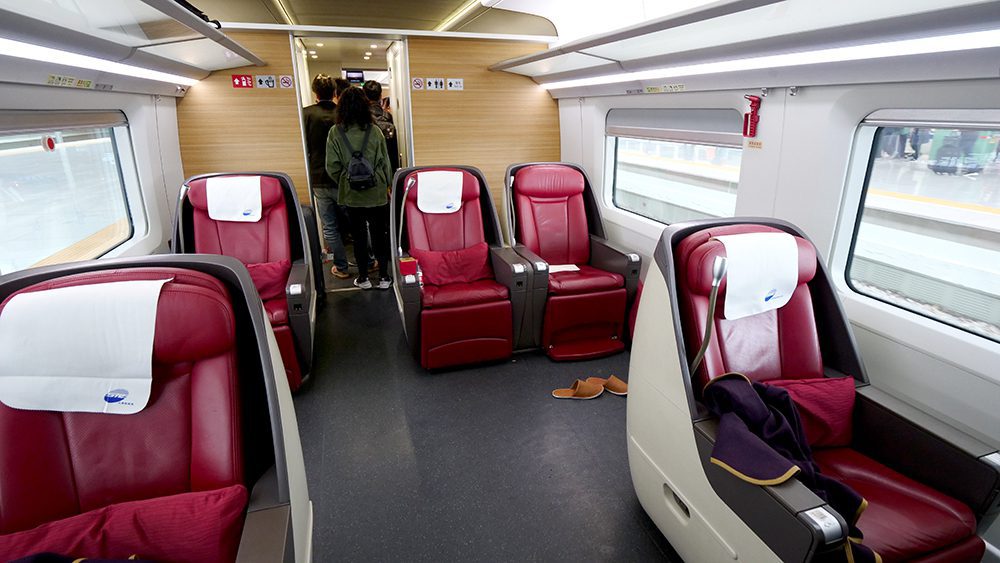Residing between the Yangtze River and Lake Tai, just 62 miles northwest of Shanghai, is the city of Suzhou. This alluring city of over 4 million is notable for its many historical sites. These historical sites make up many of the things to see and eat in Suzhou.

Suzhou’s history dates back to its founding in 514 B.C. It became one of the ten largest cities in the world during the Eastern Han dynasty around 100 A.D. Even now, Suzhou is considered one of the most prosperous and most highly developed cities in China.

Despite its development, remnants from the city’s past, including its magical gardens, ancient stone bridges, and stunning pagodas, still stand today. Its network of canals has inspired the city’s nickname, the “Venice of the East,” and is among the city’s most significant draws. These are the top 10 things to see and eat in Suzhou, China.

If you’re anything like me, you’ll be starving upon your arrival in Suzhou. With my mind (and stomach) set on Suzhou’s best street food, my guide Janet and I set off for Pingjiang Road!

Pingjiang Road, known historically as Shiquan Li, is a 1,606-meter-long historical street that is bounded by one of Suzhou’s famous canals. Walking along the street, which is more than 800 years old, feels like taking a step back in time back to the Song Dynasty.

One of the cool things about the road is that it isn’t just a place to marvel at Suzhou’s history. It’s also a great place to get food! There are stands selling sweet bread with pieces of preserved fruit inside, lots of little cakes, including some with rose, nuts, and sesame seeds. You can also find spicy vegetable snacks with chilies and a Chinese version of membrillo, which is a thick fruit jelly made from quince fruit.

For something more substantial, you can try huge portions of tiny, lightly fried freshwater shrimp and spicy clams at a nearby restaurant. They’re easily two of the best things to see and eat in Suzhou!

The highlight of just about any visit to Suzhou will likely be the boat tour you’re bound to take down its spectacular, tree-lined canals. It is this section of the city that earned it its nickname, the “Venice of the East,” which was given by Marco Polo.

You can pay the 300 Yuan/roughly $44 U.S. for a 20-30-minute private tour of Pingjiang Canal, or you can save your money and pay 40 Yuan/$5.83 U.S. for the regular tour. The boats are a very tight fit with other passengers, so you may want to go private if you’re claustrophobic.

The ride was beautiful and relaxing, and I quickly forgot about how packed the boat was. There were older, brick layers along the sides of the canals and newer layers above it. I could see carved dragons—part of the drainage system—sticking out of the walls.

When you come to Suzhou, a ride down its canals is a must. There’s no doubt in my mind that it’s one of the best things to see and eat in Suzhou.

A trip to Suzhou isn’t complete without a visit to Guan Qian Shopping Street, a 150-year-old street that’s known for its mix of modern and traditional shops. From end to end, the street is 760 meters long. It’s one of the “four famous shopping streets” in China, so it’s definitely one of the top things to see and eat in Suzhou!

Guan Qian is much narrower than Nanjing Road in Shanghai. I visited at night, so it was lit up and there were lots of boutiques, restaurants, modern retailers, and older shops. Some of the street’s oldest shops are over 100 years old!

I poked my head into a few of the clothing shops, where I found mostly American brands. There’s a cool army-inspired store that only sells camouflage print items, including some pretty sick jackets and shoes!

The main reason I visited Guan Qian Shopping Street was to try traditional Suzhou food at a restaurant called Pin Xuan Shun Ji. The restaurant had a beautiful setting and an authentic feel.

My guide Janet recommended I try the pork with vinegar, eel, oyster salad, and crab meat with tofu. I learned quickly that food in Suzhou isn’t known for having a lot of heat. Suzhou cuisine tends to be mild and more delicate than that of Shanghai and is shaped by the seafood that comes from the local canals.

The crab meat with tofu consisted of big, delicious pieces of both in a thick, almost slimy broth. It was heavenly, as was the green vegetable salad with oysters. The pork with vinegar was juicy and fatty and reminded me of tender Chinese ribs.

But the star of the meal was easily the eel. It was coated in a glazy sauce with garlic and tasted like a fish filet that had cooked in its own juices. I couldn’t believe how buttery it was. This dish alone is one of the top things to see and eat in Suzhou!

One of Suzhou’s most beautiful attractions is the Master of the Nets Garden. It was built in 1140 by a Southern Song Dynasty official named Shi Zhengzhi. Shi Zhengzhi’s inspiration were philosophical writings about a solitary Chinese fisherman. In the centuries after his death, the garden fell into disrepair until it was restored in 1785 by a retired Qing Dynasty official named Song Zongyuan. The garden was named a UNESCO World Heritage Site in 1997.

When I visited, I marveled at the tea house and women’s reception room, which contain some of the most breathtaking wooden furniture I’ve ever seen in my life. I was blown away by the massive brick-and-wood gates, which have been standing for over a thousand years. They easily make my list of the top things to see and eat in Suzhou!

There’s a beautiful study room for boys, which also serves as an open library, and a music room and open garden. Everywhere I looked, there was impeccable architecture and woodwork.

Master of the Nets Garden is also home to the smallest bridge in Suzhou. It’s considered good luck if you cross it. The oldest tree in Suzhou can also be found there and makes you realize just how long the gardens have been around. You have to see them for yourself!

When I travel, I seek out authentic food experiences. One of the best I had in Suzhou was the traditional breakfast I enjoyed on my fourth full day in China. They included xiaolongbao, a type of soup dumpling I’d had a few days earlier in Shanghai.

Xiaolongbao are chewy and filled with a hot, flavorful soup. The soup inside is so hot that I have to warn you: never eat a xiaolongbao whole. You’ll scorch your entire mouth. Instead, take a nibble of a corner and slowly suck the scalding soup out through the hole. Once the soup is gone, finish off the soup dumpling in one bite.

I also tried a light pork bone soup with chives and the skin of an egg, as well as a wonton soup. The wontons contained pork, wild vegetables, and yummy bean curd! They were already full of flavor, but I added some chilies for a kick of heat. This dish is, without question, one of the best things to see and eat in Suzhou!

As one of Suzhou’s signature attractions, the North Temple Pagoda at Bao’en Temple rises, tall and proud, over its surroundings. The nine-story octagonal pagoda, which stands 76 meters high, is the tallest in Suzhou. Its history dates back 1,700 years to the third century, though the current tower has stood since the 17th century.

The tower’s interior is off limits to visitors so it can be preserved, but during my visit, the gardens of the surrounding temple were open to the public. Among the points of interest in the hilly gardens are an intricate carving of the Buddha near the entrance; an area to pray for health and wealth; a fish pond with a small, stone bridge; and a statue of a female Buddha.

It’s such a gorgeous and peaceful place and is the perfect spot to chill and enjoy nature in the city. It’s one of my top 10 things to see and eat in Suzhou for this very reason!

One of the most famous dishes Suzhou is known for is the “Squirrel-Shaped Mandarin Fish.” Yes, that is what it’s called and yes, it’s every bit as unique as its name. This dish consists of a Chinese perch that is scored and deep-fried. The scoring process causes the fish meat to fan out and create bite-sized pieces that can easily be pulled off the body with chopsticks. The fish is then coated in a fantastic sweet-and-sour sauce.

I tried this fish at a popular local restaurant. It had a beautiful presentation and contained no bones, which made me very happy as I hate trying to eat bony fish. The sauce goes so well with the meaty fish and had me in sweet and sour heaven! This fish is one of the best things to see and eat in Suzhou, so put it on your must-do list immediately!

Suzhou is known as the silk capital of China. There are over sixty silk factories in the city. I visited two silk factories on a Saturday afternoon, the first of which had lots of informative displays. The displays explained the origin of weaving in Suzhou, silk garment exhibition halls, and the life cycle of silkworms.

At the second silk factory, I got to watch the workers spin silk! They place the silkworm cocoons in water, attach the silk string to the gears on the machine, and pull it out until they’re only left with only the pupa inside the cocoon. Each cocoon produces roughly a mile of silk. There are even double cocoons that contain a male and a female, who spin silk together.

Once the silk is extracted, the workers use templates to make various silk creations. These creations can be found in the form of duvets, bedspreads, furniture, scarves, shirts, embroidery, and more in the factory’s gift shop. Touring a silk factory and its gift shop is one of the best things to see and eat in Suzhou!

The silk products are all stunningly beautiful and are of an immaculate quality. I couldn’t help but buy a few for myself, my wife, and my father. They were too beautiful to leave behind!

In China, there are areas that feel very touristy and others that have a quieter, more local vibe. Shantang Street is a mix of both! This 2.3-mile-long pedestrian-friendly street along the Shantang River dates back to 825 A.D. It’s also known as “Seven-Mile Shantang” because the distance is equivalent to seven traditional Chinese miles.

During my visit, I enjoyed a sticky rice cake with red bean paste and chocolate-like sesame candy in the bustling commercial area.

But after passing through a tunnel, I found a quieter residential area with a more authentic feel. I explored to the beat of music played by a man using a traditional instrument. I had been suffering from a cough, so my guide Judy took me to a traditional medicine stand. There, I tried a sugary bar with a medicine-like taste, which is supposed to soothe coughs.

As I listened to the music, I also tried some juicy and fresh pineapple, which was the perfect way to cap off my tour of Shantang Street. Checking out both areas was one of my favorite things to see and eat in Suzhou!

About an hour south of Suzhou is the ancient water town of Tongli. I’m a huge history buff, so I was thrilled to learn that seventy percent of the buildings there are over 200 years old. The town is known for its network of seventeen canals, forty-five stone bridges, and meditation garden.

Note that entry into Tongli is not free. There is an entry fee of 100 Yuan, or about $14.59 U.S. You’ll be given a ticket in exchange. Don’t lose your ticket! You’ll need it later.

Once I entered Tongli, I was gobsmacked by the variety and amount of street food available, including pig parts, buns, cakes, xiaolongbao, and much more. It’s enough to make your head spin!

I stopped at a restaurant with my guide Peter and enjoyed a spinach- and cabbage-like preserved water vegetable, a moist and flavorful xiaolongbao, and a dense vegetable bun. I wrapped up my meal with a couple of sticky rice snacks, including a rice ball with red bean paste inside that reminded me of a Japanese mochi.

Back on the street, I couldn’t pass up the outstanding pork and beef jerky I came across. They tasted like Chinese ribs and had been marinating in a sauce that I couldn’t get enough of!

To enter the Retreat and Meditation Garden, you’ll need the ticket you received upon entering Tongli. These breathtaking gardens were built in 1886 by a retired official named Ren Lansheng, who wanted a place to retreat and meditate. The garden encompasses 71,000 square feet and is divided into an eastern and western section.

The eastern section includes the entry gate, entrance hall, the Tower of Gathering Beauty, the Lasting Spring and Moon Viewing Tower, and the residential buildings. The western garden is where you’ll find the celestial bridge, lotus blossoms pavilion, pond, and the Hall of Retreat and Reflection.

I couldn’t help but marvel at the gorgeous Imperial architecture. There were areas around the pond where it looked like the buildings were floating on the water! It’s easy to see why this garden was named a UNESCO World Heritage Site in 2001.

For 90 Yuan, or a little over $13 U.S., you’ll get to explore Tongli’s fascinating history on a serene boat ride down the water town’s spectacular, tree-lined canals. Your 25-minute ride will take you under three of the city’s beautiful stone bridges.

This boat ride is the best way to get a peek into local life, as you can easily people watch as you slowly drift down the waterways. This is the experience I wanted to have in China and I’m so glad I got to have it. After your tour ends, I suggest checking out the bridges on foot and exploring the old town.

The fastest and most affordable way to travel between Shanghai and Suzhou is the bullet train. The ride both ways only takes 22 minutes. You can pay 128 Yuan, or roughly $18.58 U.S. for a Business Class ticket. First class will set you back 80 Yuan, or about $11.61 U.S., and a Second Class ticket only costs 40 Yuan, or $5.81 U.S.

Have your ID and passport ready as you enter the train stations. I also suggest arriving about 90 minutes early in case you run into any issues like I did. Finally, if you can, bring along a Mandarin-speaking guide or friend who can help you with the language barrier, as very few people in China speak English.

NOTE: Before you travel, I suggest buying travel insurance to protect yourself in case any emergency situations come up. In my opinion, AXA Travel Insurance is the very best because it covers a wide array of issues. Buy your AXA Travel Insurance protection plan here!
If you need to check the visa requirements of a particular country, click here. To apply for a visa, find up-to-date visa information for different countries, and calculate the cost of a particular visa, click here!
Counter
101 Countries • 1432 Cities
Pablo Jones says:
Thank you so much for sharing this blog.